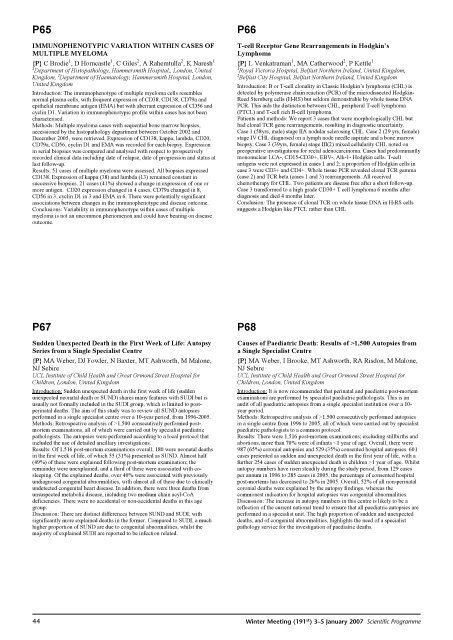2007 Winter Meeting - London - The Pathological Society of Great ...
2007 Winter Meeting - London - The Pathological Society of Great ...
2007 Winter Meeting - London - The Pathological Society of Great ...
- No tags were found...
Create successful ePaper yourself
Turn your PDF publications into a flip-book with our unique Google optimized e-Paper software.
P65IMMUNOPHENOTYPIC VARIATION WITHIN CASES OFMULTIPLE MYELOMA{P} C Brodie 1 , D Horncastle 1 , C Giles 2 , A Rahemtulla 2 , K Naresh 11 Department <strong>of</strong> Histopathology, Hammersmith Hospital,, <strong>London</strong>, UnitedKingdom, 2 Department <strong>of</strong> Haematology, Hammersmith Hospital, <strong>London</strong>,United KingdomIntroduction: <strong>The</strong> immunophenotype <strong>of</strong> multiple myeloma cells resemblesnormal plasma cells, with frequent expression <strong>of</strong> CD38, CD138, CD79a andepithelial membrane antigen (EMA) but with aberrant expression <strong>of</strong> CD56 andcyclin D1. Variation in immunophenotypic pr<strong>of</strong>ile within cases has not beencharacterised.Methods: Multiple myeloma cases with sequential bone marrow biopsies,accessioned by the histopathology department between October 2002 andDecember 2005, were retrieved. Expression <strong>of</strong> CD138, kappa, lambda, CD20,CD79a, CD56, cyclin D1 and EMA was recorded for each biopsy. Expressionin serial biopsies was compared and analysed with respect to prospectivelyrecorded clinical data including date <strong>of</strong> relapse, date <strong>of</strong> progression and status atlast follow-up.Results: 51 cases <strong>of</strong> multiple myeloma were assessed. All biopsies expressedCD138. Expression <strong>of</strong> kappa (38) and lambda (13) remained constant insuccessive biopsies. 21 cases (41%) showed a change in expression <strong>of</strong> one ormore antigen. CD20 expression changed in 4 cases, CD79a changed in 8,CD56 in 3, cyclin D1 in 3 and EMA in 6. <strong>The</strong>re were potentially significantassociations between changes in the immunophenotype and disease outcome.Conclusions: Variability in immunophenotype within cases <strong>of</strong> multiplemyeloma is not an uncommon phenomenon and could have bearing on diseaseoutcome.P66T-cell Receptor Gene Rearrangements in Hodgkin’sLymphoma{P} L Venkatraman 1 , MA Catherwood 2 , P Kettle 11 Royal Victoria Hospital, Belfast Northern Ireland, United Kingdom,2 Belfast City Hospital, Belfast Northern Ireland, United KingdomIntroduction: B or T-cell clonality in Classic Hodgkin’s lymphoma (CHL) isdetected by polymerase chain reaction (PCR) <strong>of</strong> the microdissected Hodgkin-Reed Sternberg cells (H-RS) but seldom demonstrable by whole tissue DNAPCR. This aids the distinction between CHL, peripheral T-cell lymphoma(PTCL) and T-cell rich B-cell lymphoma.Patients and methods: We report 3 cases that were morphologically CHL buthad clonal TCR gene rearrangements, resulting in diagnostic uncertainty.Case 1 (58yrs, male) stage IIA nodular sclerosing CHL. Case 2 (29 yrs, female)stage IV CHL diagnosed on a lymph node needle aspirate and a bone marrowbiopsy. Case 3 (39yrs, female) stage III(2) mixed cellularity CHL noted onpreoperative investigations for rectal adenocarcinoma. Cases had predominantlymononuclear LCA-, CD15-CD30+, EBV-, Alk-1- Hodgkin cells. T-cellantigens were not expressed in cases 1 and 2; a proportion <strong>of</strong> Hodgkin cells incase 3 were CD3+ and CD4+. Whole tissue PCR revealed clonal TCR gamma(case 2) and TCR beta (cases 1 and 3) rearrangements. All receivedchemotherapy for CHL. Two patients are disease free after a short follow-up.Case 3 transformed to a high grade CD30+ T cell lymphoma 6 months afterdiagnosis and died 4 months later.Conclusion: <strong>The</strong> presence <strong>of</strong> clonal TCR on whole tissue DNA in H-RS cellssuggests a Hodgkin like PTCL rather than CHLP67Sudden Unexpected Death in the First Week <strong>of</strong> Life: AutopsySeries from a Single Specialist Centre{P} MA Weber, DJ Fowler, N Baxter, MT Ashworth, M Malone,NJ SebireUCL Institute <strong>of</strong> Child Health and <strong>Great</strong> Ormond Street Hospital forChildren, <strong>London</strong>, United KingdomIntroduction: Sudden unexpected death in the first week <strong>of</strong> life (suddenunexpected neonatal death or SUND) shares many features with SUDI but isusually not formally included in the SUDI group, which is limited to postperinataldeaths. <strong>The</strong> aim <strong>of</strong> this study was to review all SUND autopsiesperformed in a single specialist centre over a 10-year period, from 1996-2005.Methods: Retrospective analysis <strong>of</strong> >1,500 consecutively performed postmortemexaminations, all <strong>of</strong> which were carried out by specialist paediatricpathologists. <strong>The</strong> autopsies were performed according to a local protocol thatincluded the use <strong>of</strong> detailed ancillary investigations.Results: Of 1,516 post-mortem examinations overall, 180 were neonatal deathsin the first week <strong>of</strong> life, <strong>of</strong> which 55 (31%) presented as SUND. Almost half(49%) <strong>of</strong> these were explained following post-mortem examination; theremainder were unexplained, and a third <strong>of</strong> these were associated with cosleeping.Of the explained deaths, over 40% were associated with previouslyundiagnosed congenital abnormalities, with almost all <strong>of</strong> these due to clinicallyundetected congenital heart disease. In addition, there were three deaths fromunsuspected metabolic disease, including two medium chain acyl-CoAdeficiencies. <strong>The</strong>re were no accidental or non-accidental deaths in this agegroup.Discussion: <strong>The</strong>re are distinct differences between SUND and SUDI, withsignificantly more explained deaths in the former. Compared to SUDI, a muchhigher proportion <strong>of</strong> SUND are due to congenital abnormalities, whilst themajority <strong>of</strong> explained SUDI are reported to be infection related.P68Causes <strong>of</strong> Paediatric Death: Results <strong>of</strong> >1,500 Autopsies froma Single Specialist Centre{P} MA Weber, I Brooke, MT Ashworth, RA Risdon, M Malone,NJ SebireUCL Institute <strong>of</strong> Child Health and <strong>Great</strong> Ormond Street Hospital forChildren, <strong>London</strong>, United KingdomIntroduction: It is now recommended that perinatal and paediatric post-mortemexaminations are performed by specialist paediatric pathologists. This is anaudit <strong>of</strong> all paediatric autopsies from a single specialist institution over a 10-year period.Methods: Retrospective analysis <strong>of</strong> >1,500 consecutively performed autopsiesin a single centre from 1996 to 2005, all <strong>of</strong> which were carried out by specialistpaediatric pathologists to a common protocol.Results: <strong>The</strong>re were 1,516 post-mortem examinations; excluding stillbirths andabortions, more than 70% were <strong>of</strong> infants 1 year <strong>of</strong> age. Whilstautopsy numbers have risen steadily during the study period, from 129 casesper annum in 1996 to 285 cases in 2005, the percentage <strong>of</strong> consented hospitalpost-mortems has decreased to 26% in 2005. Overall, 52% <strong>of</strong> all non-perinatalcoronial deaths were explained by the autopsy findings, whereas thecommonest indication for hospital autopsies was congenital abnormalities.Discussion: <strong>The</strong> increase in autopsy numbers in this centre is likely to be areflection <strong>of</strong> the current national trend to ensure that all paediatric autopsies areperformed in a specialist unit. <strong>The</strong> high proportion <strong>of</strong> sudden and unexpecteddeaths, and <strong>of</strong> congenital abnormalities, highlights the need <strong>of</strong> a specialistpathology service for the investigation <strong>of</strong> paediatric deaths.44 <strong>Winter</strong> <strong>Meeting</strong> (191 st ) 3–5 January <strong>2007</strong> Scientific Programme













